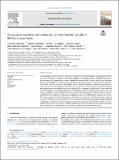Por favor, use este identificador para citar o enlazar a este item:
http://hdl.handle.net/10261/345897COMPARTIR / EXPORTAR:
 SHARE SHARE
 CORE
BASE CORE
BASE
|
|
| Visualizar otros formatos: MARC | Dublin Core | RDF | ORE | MODS | METS | DIDL | DATACITE | |

| Título: | Seasonal precipitation and continentality drive bimodal growth in Mediterranean forests |
Autor: | Valeriano, Cristina CSIC ORCID; Gutiérrez, Emilia; Colangelo, Michele CSIC ORCID; Gazol Burgos, Antonio CSIC ORCID ; Sánchez-Salguero, Raúl CSIC ORCID; Tumajer, Jan; Shishov, Vladimir V.; Bonet, José Antonio; Martínez de Aragón, Juan; Ibáñez, Ricardo; Valerio, Mercedes; Camarero, Jesús Julio CSIC ORCID | Palabras clave: | Juniperus Vaganov-Shashkin model Phenology Pinus Radial growth Xylogenesis |
Fecha de publicación: | abr-2023 | Editor: | Elsevier | Citación: | Dendrochronologia 78: 126057 (2023) | Resumen: | Tree phenology is sensitive to climate warming and changes in seasonal precipitation. Long xylogenesis records are scarce, thus limiting our ability to analyse how radial growth responds to climate variability. Alternatively, process-based growth models can be used to simulate intra-annual growth dynamics and to better understand why growth bimodality varies along temperature and precipitation gradients. We used the Vaganov-Shashkin (VS) growth model to analyse the main climatic drivers of growth bimodality in eight trees and shrubs conifers (four pines and four junipers) across Spain. We selected eleven sites with different continentality degree and spring/autumn precipitation ratios since we expected to find pronounced bimodal growth in less continental sites with spring and autumn precipitation peaks. The VS model successfully simulated annual growth rates at all sites as a function of daily temperature and soil moisture data. Bimodal growth patterns clustered into less continental sites showing low spring/autumn precipitation ratios. This finding agrees with observed climate-growth associations showing that growth was enhanced by wet-cool winter-to-spring conditions, but also by wet autumn conditions in the most bimodal sites. We observed a stronger growth bimodality in pines compared to junipers. We discuss the spatial variability of climate drivers in bimodality growth pattern and how increasing continentality and shifts in seasonal precipitation could affect growth patterns. Bimodality could be an advantageous response to overcome summer drought in Mediterranean forests. The ability of some species to reactivate growth during autumn might determine their capacity to withstand increasing summer aridity. | Descripción: | © 2023 The Author(s). Published by Elsevier GmbH. This is an open access article under the CC BY-NC-ND license (http://creativecommons.org/licenses/by-nc-nd/4.0/). | Versión del editor: | https://doi.org/10.1016/j.dendro.2023.126057 | URI: | http://hdl.handle.net/10261/345897 | DOI: | 10.1016/j.dendro.2023.126057 | ISSN: | 1125-7865 | E-ISSN: | 1612-0051 |
| Aparece en las colecciones: | (IPE) Artículos |
Ficheros en este ítem:
| Fichero | Descripción | Tamaño | Formato | |
|---|---|---|---|---|
| Seasonal_Dendrochronologia_2023_OA.pdf | 4,26 MB | Adobe PDF |  Visualizar/Abrir |
CORE Recommender
SCOPUSTM
Citations
14
checked on 21-abr-2024
WEB OF SCIENCETM
Citations
11
checked on 21-feb-2024
Page view(s)
8
checked on 26-abr-2024
Download(s)
13
checked on 26-abr-2024
Google ScholarTM
Check
Altmetric
Altmetric
Este item está licenciado bajo una Licencia Creative Commons

